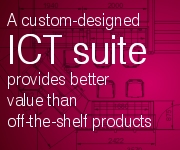What does it cost?
Overview
In schools, there are typically two costs that will account for most of the network infrastructure investment: network switches and network cabling. There are many factors that will affect costs (both positively and negatively), and we will do our best to find the best value route for you. Adhering to the BECTA standard does not mean incurring onerous costs. Below are some of the factors that we know will impact costs, all of which we would take account of during a site-survey.
Network switches
Switches should be carefully specified so that they provide what you need, but not excessive features that you don't need. We will assess your needs (capacity, application, future-proofing, resilience, flexibility, existing hardware), take into account the BECTA requirements, and recommend the best value switches that will satisfy all requirements at the minimum costs.
Age and type of building
New buildings often have cable-trays fitted in suspended ceilings, making cable runs relatively simple. Older buildings tend to have high ceilings and very little accommodation for cabling which often means fitting cable trunking.
The layout of the building
If your building is compact with two or more floors, the cable routing is likely to be more simple than if it is spread over a large area on a single level. A connection between buildings may be more cost-effective with line-of-sight wireless link rather than cabling.
Existing network infrastructure
If you already have a network in place, there is a good chance that we can use some of your existing containment (cable-trays, trunking, etc) instead of running new. If we are replacing cable (eg, upgrading CAT5 to CAT5e), we will almost certainly be able to re-use what you already have. CAT5e to CAT6 or fibre may require some changes to reduce corner radii, but again, we can probably re-use much of what you already have.
Presence of asbestos
Asbestos may require us to route cables differently, or contain cables in trunking. We will be able to determine this by examining your asbestos register and a site survey.
Overview
In schools, there are typically two costs that will account for most of the network infrastructure investment: network switches and network cabling. There are many factors that will affect costs (both positively and negatively), and we will do our best to find the best value route for you. Adhering to the BECTA standard does not mean incurring onerous costs. Below are some of the factors that we know will impact costs, all of which we would take account of during a site-survey.
Network switches
Switches should be carefully specified so that they provide what you need, but not excessive features that you don't need. We will assess your needs (capacity, application, future-proofing, resilience, flexibility, existing hardware), take into account the BECTA requirements, and recommend the best value switches that will satisfy all requirements at the minimum costs.
Age and type of building
New buildings often have cable-trays fitted in suspended ceilings, making cable runs relatively simple. Older buildings tend to have high ceilings and very little accommodation for cabling which often means fitting cable trunking.
The layout of the building
If your building is compact with two or more floors, the cable routing is likely to be more simple than if it is spread over a large area on a single level. A connection between buildings may be more cost-effective with line-of-sight wireless link rather than cabling.
Existing network infrastructure
If you already have a network in place, there is a good chance that we can use some of your existing containment (cable-trays, trunking, etc) instead of running new. If we are replacing cable (eg, upgrading CAT5 to CAT5e), we will almost certainly be able to re-use what you already have. CAT5e to CAT6 or fibre may require some changes to reduce corner radii, but again, we can probably re-use much of what you already have.
Presence of asbestos
Asbestos may require us to route cables differently, or contain cables in trunking. We will be able to determine this by examining your asbestos register and a site survey.


